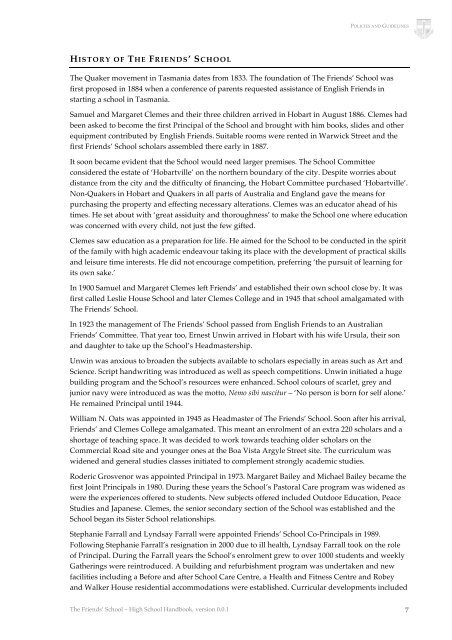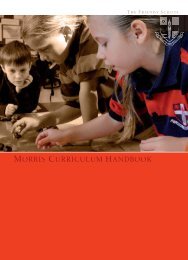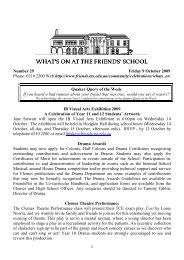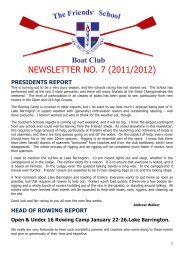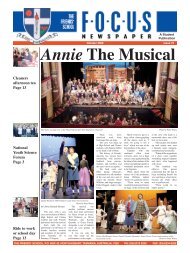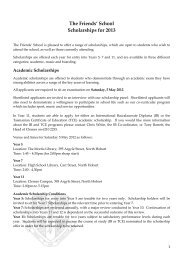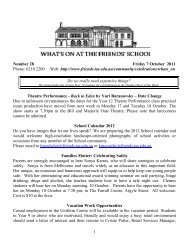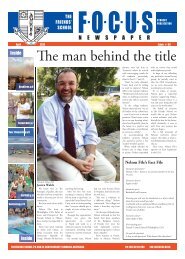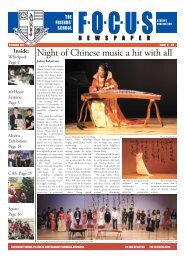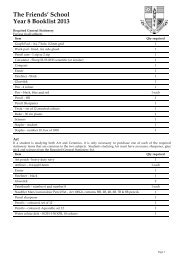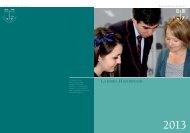HIGH SCHOOL HANDBOOK - The Friends' School
HIGH SCHOOL HANDBOOK - The Friends' School
HIGH SCHOOL HANDBOOK - The Friends' School
- No tags were found...
You also want an ePaper? Increase the reach of your titles
YUMPU automatically turns print PDFs into web optimized ePapers that Google loves.
POLICIES AND GUIDELINESHISTORY OF THE FRIENDS’ <strong>SCHOOL</strong><strong>The</strong> Quaker movement in Tasmania dates from 1833. <strong>The</strong> foundation of <strong>The</strong> Friends’ <strong>School</strong> wasfirst proposed in 1884 when a conference of parents requested assistance of English Friends instarting a school in Tasmania.Samuel and Margaret Clemes and their three children arrived in Hobart in August 1886. Clemes hadbeen asked to become the first Principal of the <strong>School</strong> and brought with him books, slides and otherequipment contributed by English Friends. Suitable rooms were rented in Warwick Street and thefirst Friends’ <strong>School</strong> scholars assembled there early in 1887.It soon became evident that the <strong>School</strong> would need larger premises. <strong>The</strong> <strong>School</strong> Committeeconsidered the estate of ‘Hobartville’ on the northern boundary of the city. Despite worries aboutdistance from the city and the difficulty of financing, the Hobart Committee purchased ‘Hobartville’.Non-Quakers in Hobart and Quakers in all parts of Australia and England gave the means forpurchasing the property and effecting necessary alterations. Clemes was an educator ahead of histimes. He set about with ‘great assiduity and thoroughness’ to make the <strong>School</strong> one where educationwas concerned with every child, not just the few gifted.Clemes saw education as a preparation for life. He aimed for the <strong>School</strong> to be conducted in the spiritof the family with high academic endeavour taking its place with the development of practical skillsand leisure time interests. He did not encourage competition, preferring ‘the pursuit of learning forits own sake.’In 1900 Samuel and Margaret Clemes left Friends’ and established their own school close by. It wasfirst called Leslie House <strong>School</strong> and later Clemes College and in 1945 that school amalgamated with<strong>The</strong> Friends’ <strong>School</strong>.In 1923 the management of <strong>The</strong> Friends’ <strong>School</strong> passed from English Friends to an AustralianFriends’ Committee. That year too, Ernest Unwin arrived in Hobart with his wife Ursula, their sonand daughter to take up the <strong>School</strong>’s Headmastership.Unwin was anxious to broaden the subjects available to scholars especially in areas such as Art andScience. Script handwriting was introduced as well as speech competitions. Unwin initiated a hugebuilding program and the <strong>School</strong>’s resources were enhanced. <strong>School</strong> colours of scarlet, grey andjunior navy were introduced as was the motto, Nemo sibi nascitur – ‘No person is born for self alone.’He remained Principal until 1944.William N. Oats was appointed in 1945 as Headmaster of <strong>The</strong> Friends’ <strong>School</strong>. Soon after his arrival,Friends’ and Clemes College amalgamated. This meant an enrolment of an extra 220 scholars and ashortage of teaching space. It was decided to work towards teaching older scholars on theCommercial Road site and younger ones at the Boa Vista Argyle Street site. <strong>The</strong> curriculum waswidened and general studies classes initiated to complement strongly academic studies.Roderic Grosvenor was appointed Principal in 1973. Margaret Bailey and Michael Bailey became thefirst Joint Principals in 1980. During these years the <strong>School</strong>’s Pastoral Care program was widened aswere the experiences offered to students. New subjects offered included Outdoor Education, PeaceStudies and Japanese. Clemes, the senior secondary section of the <strong>School</strong> was established and the<strong>School</strong> began its Sister <strong>School</strong> relationships.Stephanie Farrall and Lyndsay Farrall were appointed Friends’ <strong>School</strong> Co-Principals in 1989.Following Stephanie Farrall’s resignation in 2000 due to ill health, Lyndsay Farrall took on the roleof Principal. During the Farrall years the <strong>School</strong>’s enrolment grew to over 1000 students and weeklyGatherings were reintroduced. A building and refurbishment program was undertaken and newfacilities including a Before and after <strong>School</strong> Care Centre, a Health and Fitness Centre and Robeyand Walker House residential accommodations were established. Curricular developments included<strong>The</strong> Friends’ <strong>School</strong> – High <strong>School</strong> Handbook, version 0.0.1 7


